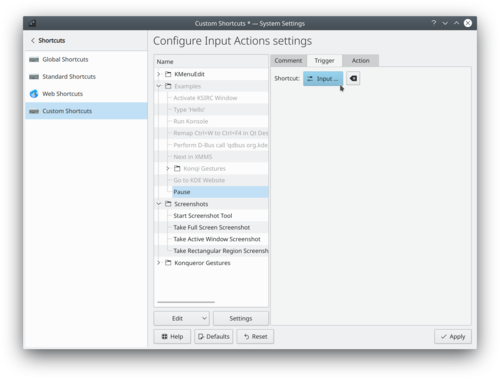Tutorials/hotkeys: Difference between revisions
No edit summary |
(link to an explanation how to open a console) |
||
| Line 1: | Line 1: | ||
With KDE you can set any key or a combination of keys to trigger an action on your computer. As an example: when I ''pause'' my work I want to lock my screen with the ''Pause'' key so my colleagues cannot [http://zvon.org/comp/r/ref-Jargon_file.html#Terms~baggy_pantsing baggy-pants] me. Here is how to do that. | With KDE you can set any key or a combination of keys to trigger an action on your computer. As an example: when I ''pause'' my work I want to lock my screen with the ''Pause'' key so my colleagues cannot [http://zvon.org/comp/r/ref-Jargon_file.html#Terms~baggy_pantsing baggy-pants] me. Here is how to do that. | ||
* [ | * [http://www.linuxintro.org/wiki/oPen_a_conSole open a console] | ||
* call the | * call the command | ||
systemsettings | systemsettings | ||
* select "Shortcuts and Gestures" -> "Custom Shortcuts" -> "Edit" -> "New" -> "Global Shortcut" -> "Command/URL" -> enter "Pause" | * select "Shortcuts and Gestures" -> "Custom Shortcuts" -> "Edit" -> "New" -> "Global Shortcut" -> "Command/URL" -> enter "Pause" | ||
Revision as of 15:00, 7 November 2014
With KDE you can set any key or a combination of keys to trigger an action on your computer. As an example: when I pause my work I want to lock my screen with the Pause key so my colleagues cannot baggy-pants me. Here is how to do that.
- open a console
- call the command
systemsettings
- select "Shortcuts and Gestures" -> "Custom Shortcuts" -> "Edit" -> "New" -> "Global Shortcut" -> "Command/URL" -> enter "Pause"
- click on Trigger -> "None"
- type the PAUSE key
- click on "Action"
- enter
qdbus org.kde.screensaver /ScreenSaver org.freedesktop.ScreenSaver.Lock
or (whatever works)
/usr/lib64/kde4/libexec/kscreenlocker_greet
or (whatever works)
/usr/lib64/kde4/libexec/kscreenlocker --forcelock
- click "Apply"
- test it by pressing the PAUSE key

